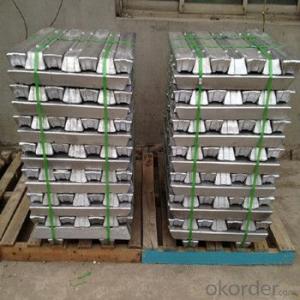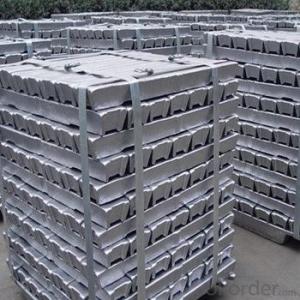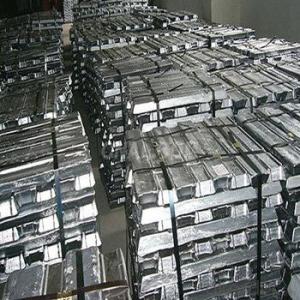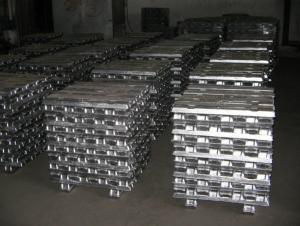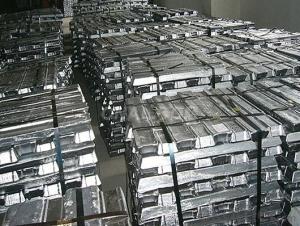Aluminum Pig/Ingot With Good Quality And Good Pirce
- Loading Port:
- China main port
- Payment Terms:
- TT OR LC
- Min Order Qty:
- 1000 m.t.
- Supply Capability:
- 100000 m.t./month
OKorder Service Pledge
OKorder Financial Service
You Might Also Like
Pure Aluminum Pig/Ingot Used for Industry
1.Structure of Aluminum Pig/Ingot
A material that has been cast into a shape in order to be transported and processed easier than in an unprocessed form. An ingot is typically rectangular in shape, which allows it to be stacked. Ingots are most commonly associated with metals, with ingots of gold held in the vaults of banks and brokerages being popular images.
Aluminum Ingot is with the AL as the main chemical composition.Aluminum Ingot is used for industry,such as automobile,pinning and weaving,electron broadly and so on. Aluminum Ingot has the following advantages: easy control and operation, fast melting.
2.Main Features of the Aluminum Pig/Ingot
•High Purity
•Easy control and operation
•High strength
•Fast melting
•Competitive price
•Best Service
3.Aluminum Pig/Ingot Images
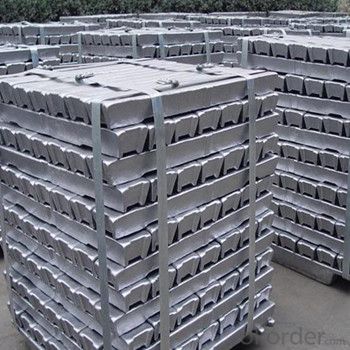
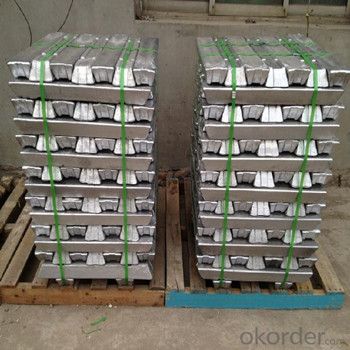
4.Aluminum Pig/Ingot Specification
Grade | Chemical Composition % | |||||||||
Al≥ | impurities ≤ | |||||||||
Si | Fe | Cu | Ga | Mg | Zn | Mn | others | Sum | ||
Al99.9 | 99.90 | 0.50 | 0.07 | 0.005 | 0.02 | 0.01 | 0.025 | - | 0.010 | 0.10 |
Al99.85 | 99.85 | 0.80 | 0.12 | 0.005 | 0.03 | 0.02 | 0.030 | - | 0.015 | 0.15 |
Al99.7 | 99.70 | 0.10 | 0.20 | 0.010 | 0.03 | 0.02 | 0.030 | - | 0.030 | 0.30 |
Al99.6 | 99.60 | 0.16 | 0.25 | 0.010 | 0.03 | 0.03 | 0.030 | - | 0.030 | 0.40 |
Al99.5 | 99.50 | 0.22 | 0.30 | 0.020 | 0.03 | 0.05 | 0.050 | - | 0.030 | 0.50 |
Al99.00 | 99.00 | 0.42 | 0.50 | 0.020 | 0.03 | 0.05 | 0.050 | - | 0.050 | 1.00 |
5.FAQ of Aluminum Pig/Ingot
We have organized several common questions for our clients,may help you sincerely:
①How about your company?
A professional factory which foucs on producing the aluminum pig,can meet customers' requiement to the quality and grade.The quality also have been accepted by customer.Already got the good reputation among the customers.It have gotten lot of much experience.The facrtory has the professional Technical Worker and the advanced equipments for production.Beside,it has the profesional teams to operate the whole proess for exporting.OEM service is availble and welcome.The items have beedn exported around the world,and have been acceptable among the customers,and have gotten the good reputation already.No matter from the quality,price and service,can be guaranteed for the cusgtomers.High purity and diffent grade are available.
②How to guarantee the quality of the products?
We have established the international advanced quality management system,every link from raw material to final product we have strict quality test;We resolutely put an end to unqualified products flowing into the market. At the same time, we will provide necessary follow-up service assurance.
③How long can we receive the prod rking days, We will arrange the factory delivery as soon as possible. The pecific time of receiving is related to the state and position of customers.Commonly 7 to 10 working days can be served.
- Q:Why milling through milling machine before rolling aluminium ingot?
- But because it has the casting casting defects, so you can also be arranged in the hot milling surface after the removal of casting defects, because after rolling into aluminum coil, milling time loss, ingot milling time is short, low cost and convenient; milling; if it is heated or hot when the oxide layer is large the material, there is no way, can only increase the milling process after hot rolling; copper, aluminum oxide and iron is not the same, the west is mainly to remove casting defects, milling the material there, air bubbles, porosity and other defects, if made of materials like aluminum foil is not possible
- Q:How are aluminum ingots used in the production of railway components?
- Aluminum ingots are used in the production of railway components as they serve as the raw material for casting or forging various parts such as frames, body panels, doors, windows, and even wheels. These ingots are melted down and then shaped into the desired components through processes like extrusion or machining. The use of aluminum in railway components offers advantages like lightweight construction, corrosion resistance, and improved energy efficiency.
- Q:What are the environmental benefits of using aluminum ingots in manufacturing?
- Using aluminum ingots in manufacturing processes brings about various environmental advantages. To begin with, aluminum is an extremely recyclable material that can be reused multiple times without losing its quality or properties. This means that the utilization of aluminum ingots reduces the necessity for extracting and processing raw materials, thereby conserving natural resources and decreasing energy consumption. Moreover, recycling aluminum emits significantly lower greenhouse gas emissions in comparison to the production of new aluminum from primary sources. Additionally, aluminum is both lightweight and durable, making it an ideal material for a wide range of applications. By incorporating aluminum ingots into manufacturing, one can contribute to the production of lighter and more fuel-efficient vehicles, thus reducing carbon emissions from transportation. Similarly, using lightweight aluminum components in construction can lead to energy savings during operation and a decreased overall carbon footprint of structures. Furthermore, aluminum exhibits excellent corrosion resistance, which extends the lifespan of products made with aluminum ingots. This prolonged durability reduces the frequency of replacements, resulting in less waste generation and a reduced demand for new materials. Through the utilization of aluminum ingots, manufacturers can actively contribute to a more circular economy by promoting the reuse and longevity of products. Moreover, aluminum ingots possess a lower melting point compared to many other metals, requiring less energy for processing and manufacturing. This reduced energy requirement translates into lower carbon dioxide emissions and overall energy consumption during the production process. Lastly, aluminum is non-toxic and non-magnetic, making it suitable for a wide array of applications, including food packaging and medical equipment. This ensures that products made with aluminum ingots do not pose health risks or disrupt sensitive equipment. In conclusion, the employment of aluminum ingots in manufacturing processes brings forth numerous environmental benefits. From its recyclability and lightweight properties to its corrosion resistance and low energy requirements, aluminum ingots contribute to the conservation of resources, decreased emissions, and a more sustainable and circular economy.
- Q:What are the different methods for machining aluminum ingots?
- There are several different methods for machining aluminum ingots, depending on the desired shape, size, and accuracy required for the final product. Some of the common methods include: 1. Milling: This is a process where a rotating cutter removes material from the ingot to create the desired shape. It is suitable for creating flat surfaces, slots, and holes. 2. Turning: In this method, the ingot is rotated while a cutting tool removes material to create cylindrical shapes. Turning can be used to create shafts, rods, and other cylindrical components. 3. Drilling: Drilling is a process where a rotating tool with cutting edges is used to create holes in the aluminum ingot. It is commonly used to create holes of various sizes and depths. 4. Grinding: Grinding involves using abrasive wheels or belts to remove material from the ingot's surface, creating a smooth and precise finish. It is often used to achieve tight tolerances and precise dimensions. 5. Sawing: Sawing is a process where a saw blade cuts through the aluminum ingot to create desired shapes or separate the ingot into smaller pieces. It is commonly used for cutting aluminum ingots into bars or smaller billets. 6. Waterjet cutting: Waterjet cutting uses a high-pressure stream of water mixed with abrasive particles to cut through the aluminum ingot. This method can create complex shapes and does not generate heat, making it suitable for cutting delicate or heat-sensitive materials. 7. Electrical discharge machining (EDM): EDM is a process that uses electrical sparks to remove metal from the aluminum ingot. This method is often used for intricate or detailed shapes that are difficult to achieve with conventional machining methods. It is important to select the appropriate machining method based on the specific requirements of the aluminum ingot and the desired final product. Factors such as the ingot's size, shape complexity, tolerance requirements, and material characteristics will influence the choice of machining method.
- Q:How are aluminum ingots alloyed with other metals?
- Various methods can be utilized to alloy aluminum ingots with other metals. Melting is a common technique in which aluminum ingots and the desired alloying metal are fused together at high temperatures, enabling the atoms of the two metals to blend and create a homogeneous mixture. This method is frequently employed for alloys with low melting points or when a uniform distribution of the alloying metal is necessary. Another approach is casting, where molten aluminum is poured into a mold containing a specified amount of the alloying metal. As the aluminum cools and solidifies, it incorporates the alloying metal into its structure, resulting in an alloy. Casting is often used for alloys that require precise compositions and when a specific shape or form is desired. Powder metallurgy is another method for alloying aluminum ingots. In this process, powdered forms of aluminum and the alloying metal are meticulously mixed together. The mixture is then compressed under high pressure and heated to a temperature below the melting point of the aluminum. This allows the atoms of the alloying metal to diffuse into the aluminum particles, producing a solid-state alloy. Additionally, electroplating and vapor deposition can also be employed to alloy aluminum ingots with other metals. These methods involve depositing a thin layer of the alloying metal onto the surface of the aluminum ingots through either electrochemical or physical processes. In conclusion, there are various techniques available for alloying aluminum ingots with other metals, each having its own advantages and applications. The choice of method depends on factors such as the desired composition, required physical properties, and the specific manufacturing process involved.
- Q:How are aluminum ingots used in the production of marine vessels?
- Aluminum ingots are used in the production of marine vessels as they are melted down and cast into various components such as hulls, decks, and superstructures. These ingots provide the necessary strength, durability, and corrosion resistance required for marine applications. Additionally, aluminum ingots can be easily formed and welded, making them an ideal material for constructing lightweight yet sturdy ships and boats.
- Q:Are aluminum alloy ADC12 and aluminium ingot ADC12 the same?What's the difference? The price you see in Ali looks different
- But 40000 is not possible, first look at the ingredients, in the upper, aluminum screen, die casting network to see, a lot of comparison, friends, your company do die casting it? I hope you can make a friend.
- Q:How can I make a pop top aluminum ingot?
- Production of miscellaneous aluminium ingots by mixing with other waste aluminum;A deoxidizer used in steelmaking;Production of aluminum: the waste cans in the rotary kiln for stripping paint processing, and then processing, production of low-grade aluminum powder.
- Q:Can aluminum ingots be used in the production of jewelry?
- Yes, aluminum ingots can be used in the production of jewelry. Aluminum is a versatile metal that can be easily molded and shaped into various jewelry designs. It is lightweight, making it comfortable to wear, and it has a natural silver-like appearance that can be further enhanced through different surface finishes, such as polishing or anodizing. Additionally, aluminum is hypoallergenic, making it a suitable choice for individuals with sensitive skin. While aluminum is not as valuable as precious metals like gold or silver, it offers a more affordable option for jewelry making and can be combined with other materials to create unique and stylish pieces.
- Q:What method does common smelting aluminium ingot adopt now?
- Due to coal and coke can precisely control the temperature, material loss is large, will not be considered; oil and natural gas are influenced by energy prices, the international economic recovery price will rise, the price is also expensive fuel now than power consumption, also not be considered;
1. Manufacturer Overview |
|
|---|---|
| Location | |
| Year Established | |
| Annual Output Value | |
| Main Markets | |
| Company Certifications | |
2. Manufacturer Certificates |
|
|---|---|
| a) Certification Name | |
| Range | |
| Reference | |
| Validity Period | |
3. Manufacturer Capability |
|
|---|---|
| a)Trade Capacity | |
| Nearest Port | |
| Export Percentage | |
| No.of Employees in Trade Department | |
| Language Spoken: | |
| b)Factory Information | |
| Factory Size: | |
| No. of Production Lines | |
| Contract Manufacturing | |
| Product Price Range | |
Send your message to us
Aluminum Pig/Ingot With Good Quality And Good Pirce
- Loading Port:
- China main port
- Payment Terms:
- TT OR LC
- Min Order Qty:
- 1000 m.t.
- Supply Capability:
- 100000 m.t./month
OKorder Service Pledge
OKorder Financial Service
Similar products
New products
Hot products
